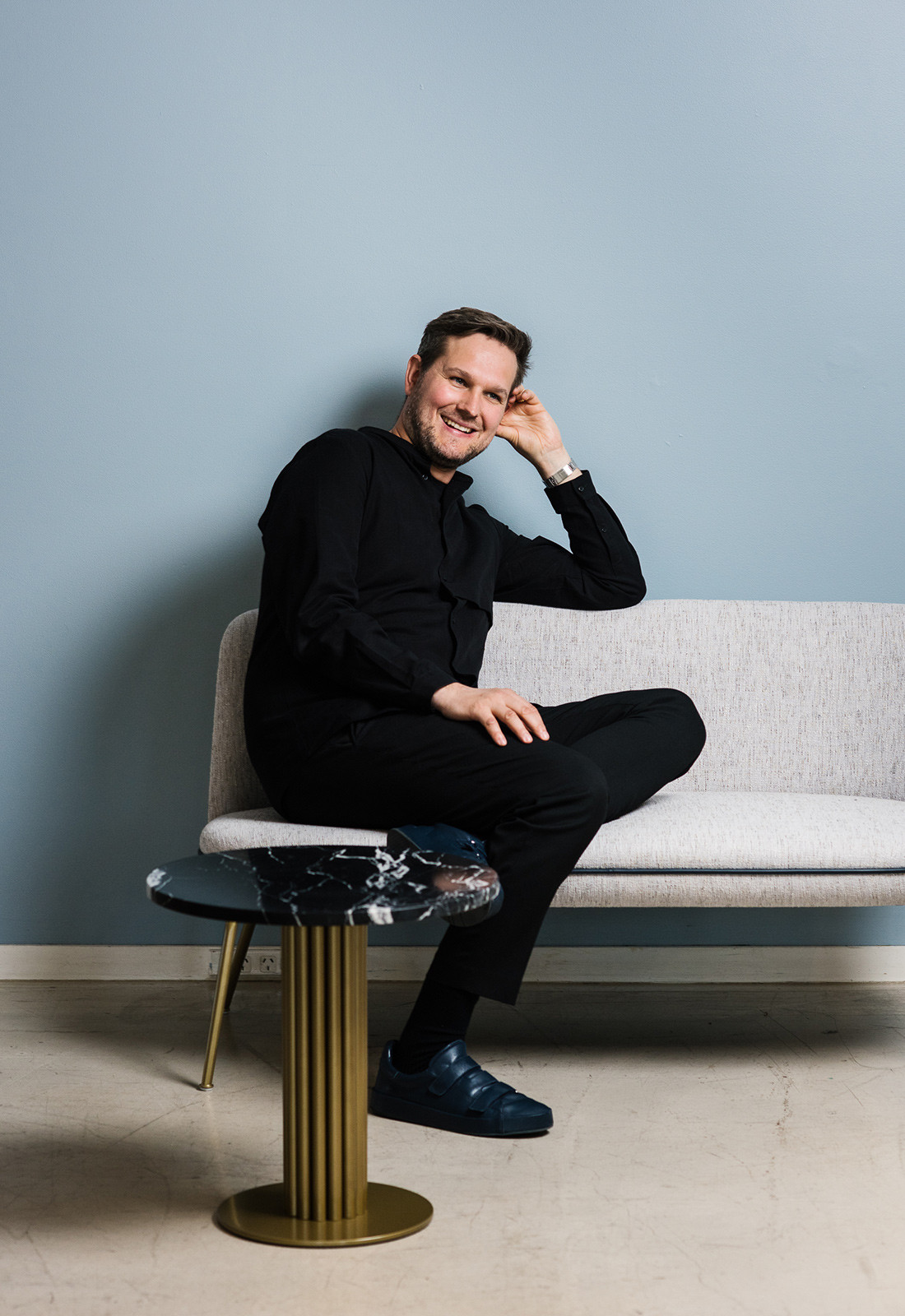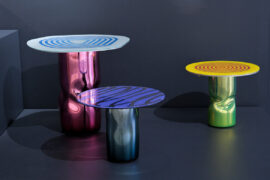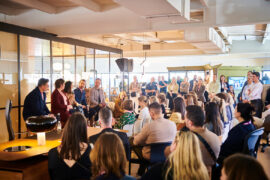In a world that feels less and less clear-cut, designer Sebastian Herkner upholds a philosophy of the specific that presents us with a cure for identity crisis.

December 26th, 2019
“When I was a child,” says Sebastian Herkner, “I would travel around Europe with my parents. We would stop at a village, and often this village was dedicated to crafts. This one would be dedicated to ceramics, that one to gloves – and things like that. Even as a little child, I was always interested in the crafts of these places.
I think that’s where it all started – my journey into the design world.
As far as journeys go, this one is fairly enviable. From boyhood reconnoitres of Europe’s company towns to, earlier this year, being awarded one of the design industry’s highest accolades – Maison&Objet’s 2019 Designer of the Year – Herkner’s career trajectory can only be summed up as preternatural.

Meryn Chair for Wittmann by Sebastian Herkner. Photography: Gregor Titze.
“He’s made it!” say some. And perhaps they’re right. After all, in the possession of accolades some designers spend half-centuries chasing, it would appear that at the youthful age of 37 Herkner is already flirting with luminary status.
The credentials stack up to suggest as much: a German Design Award, Cologne IMM’s Das Haus, a Red Dot, the IF Award, the Iconic EDIDA Award – not to mention stints with Stella McCartney, Moroso, ClassiCon, Cappellini and now Wittmann, among other stalwart brands. Laurels aplenty – but he refuses to rest.
So much so, in fact, it was a stroke of luck I even caught him in Sydney. He had just arrived from Perth, via Europe, Asia and a brief visit to Zimbabwe. He was off again in the morning. I ask if he finds it exhausting to travel so often. “No. It is so important to how I work. Opening myself up to new experiences, people and objects, I find inspiration every time.”

Stellar Grape Lighting for Pulpo by Sebastian Herkner.
And without fail seemingly every time, he’ll find something more concrete, too. During our talk he excitedly describes Bulgarian cake pans, French secateurs, Malawian woven baskets and Chinese brushes travelling in his suitcase from the farthest-flung climes, eventually finding home back in his Offenbach studio in Germany. From here, they’ll rouse into new life inspiring, say, a chair for Thonet or lamp for Gubi.
Macarons are a recent acquisition – I could just tell.
“Do you know Ladurée, the pâtisserie in Paris?” he asks me (and boy, do I ever!). “When I was there looking at the macarons, I thought their form was so perfect – they have a kind of elegance and confidence, you know? – and it was something very similar to what I wanted to achieve for Wittmann’s Merwyn collection.”
I look down at my chair. Sure enough, it’s a macaron: two round, flat-top domes sandwiched together and ringed with a strip of leather piping, à la cream. Elsewhere is a table I immediately imagine to be inspired by boiled sweets melting in the sunshine (Pastille Table, Edition Van Treeck), and a lamp evidently taking cues from those tightly bunched Concord grapes with pearlescent, chalky flesh (Stellar Grape lighting for Pulpo).

Miles Pouflonge for Wittmann by Sebastian Herkner. Photography: Gregor Titze.
I need little prompting to learn the back stories. In each instance, Herkner launches right into a narrative so furnished with details – what object caught his attention, the life of the community using it, how it was made – and suddenly it hits me. That is what inspires him. Not travel, not objects, but that curious and fragile nature of happenstance when people, material and place collide. For him, a cake pan is anything but.
“What is specific about it?” he asks. Well, it’s a celebration of Bulgaria’s metallurgic ecology; it’s generations of blacksmithing between the mountains of Rila and Vitosha where craft histories of the Mediterranean, the East and Europe converge; it’s comradeship, hospitality, open-heartedness. Not a cake pan in the world, but the whole world in a cake pan.
Germans call this geist. Aristotle called it haecceitas – or roughly, ‘thisness’. Herkner calls it responsibility. “Craft is so much about identity,” he says. “As a designer, it is my responsibility to understand and examine how craft is this element that connects us together and then connects us to a place. We need to respect it.”
“In Offenbach where I studied, and where I still have a studio, you enter the city by driving past a sign saying, German Weather City. The weather forecasting institute is there. But it also says German Leather City, too, because there was, in the past, a production of belts, wallets, shoes and bags and all these leathergoods. Eventually, it lost its identity. All the leather production left. There are still a few beautiful factory buildings, but they’re quickly becoming apartments, lofts and offices. There is no longer this thing which connected so many people together and made them proud of their town and each other. Craft and design is so important in this – and not just furniture. It can be a bakery, a butcher or even a farm, but it’s all connected with craftsmanship, quality and people.”

Merwyn Collection for Wittmann by Sebastian Herkner. Photography: Gregor Titze.
As he tells me this, I can’t help being saddened. I think of Friuli Venezia Giulia (the Chair District) where more than 10 municipalities produce a smaller and smaller percentage of the world’s chairs per annum. I think of places like Torino, Leipzig, Bilbao, Lille and St Etienne, where the 2008 crash and the ‘eurozone crisis’ have made it difficult for these once-bustling industrial cities to now round a corner.
And closer to home, I think of communities wringing their hands in abandoned steel towns throughout Australia.
“I don’t know if my work is political,” Herkner tells me toward the end of our conversation, “or if it is about the way we are living. When I give lectures, they are about things like quality, patience, craft taking time. But I know we live in a quite paradoxical world. You can buy something on AmazonPrime and you get it the same day. If you don’t like it, you can send it back. Where is the respect for craft and people in this? We just consume it all too quickly. I think this is where the interest in materials has grown a lot recently. We want to be connected back to the thing, that place and the craftspeople’s skills. That’s the paradox. We want these traditional things, the old things. But we are being pulled into the future. I think it is our responsibility to shape what it can be.”

Sebastian Herkner was recently in Australia to launch Wittmann at DOMO.
INDESIGN is on instagram
Follow @indesignlive
A searchable and comprehensive guide for specifying leading products and their suppliers
Keep up to date with the latest and greatest from our industry BFF's!

Welcomed to the Australian design scene in 2024, Kokuyo is set to redefine collaboration, bringing its unique blend of colour and function to individuals and corporations, designed to be used Any Way!

The undeniable thread connecting Herman Miller and Knoll’s design legacies across the decades now finds its profound physical embodiment at MillerKnoll’s new Design Yard Archives.

International design superstar Jaime Hayon met us at the Wittmann showroom during Milan Design Week 2025 to talk us through his new KOLINAS sofa collection.

So many product launches – where to begin with Milan? Well, across some of our favourite brands and all kinds of areas, here are some of the highlights we saw this year.
The internet never sleeps! Here's the stuff you might have missed

Despite its long and rich history, signwriting is a profession in decline. Will Lynes’ new show, Oily Water at Canberra Glassworks, aims to showcase the techniques of the trade to highlight its potential in design.

Curated by the Indesign editorial team and hosted at leading showrooms, the Design Discussions series provided thoughtful reflection and debate on key issues shaping the industry.